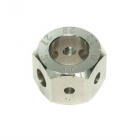My own perspective to: "Seating Depth effects on accuracy" is:
I believe that the transitions stages from static friction into kinetic friction thresholds of motion are primarily why we see different performance levels to seating depth adjustments. These transitions induce bullet "flutter" and instability factors at different points as the bullet are in motion and engaging the bore, that all come into play. The friction resistance factors to the applied force on the bullets from the ignited powder gases to the chambered barrel steel, are sensitive to surface tension differences between various bullet shapes, sizes, weights, and jacket material, as the bullet is propelled in motion and engaging the rifled bore.
Static Friction:
- The force between two bodies in contact, which resists the initiation of sliding motion.
- Also referred to as: “Starting Friction”.
Kinetic Friction:
- Surface resistance to relative motion, as of a body sliding or rolling.
- The rubbing of the surface of one body against that of another.
- Also referred to as: “Dynamic or Sliding Friction”.
The difference between Static Friction and Kinetic Friction is: static friction occurs when the object is stationary and trying to start moving, while kinetic friction takes place when the object is moving and in motion.
<> Our control to Static/Starting Friction is done by neck surface preparation, neck tension, and the amount of case neck holding the bullet.
<> Our control to Kinetic/Sliding Friction is done by seating depth distance in relation to the lands/rifling.
Bullet deformation is an ongoing certainty. The amount of deformation is dependent on bore/groove diameters in relation to the bullet diameter, and the bullets jacket material and core structure. Balance instabilities are caused by different amounts of bullet deformation, from one bullet to the next.
These bullet deformation variances are in part steered by the amount of friction induced flutter and to the direction it influences. This flutter pushes the bullet off center, causing the bullet alignment and deformation to be slightly off center as it is engaging the bore. The deformation variances then create certain amounts of instability between bullets, which ultimately affect the point of impacts and accuracy level on the target.
Basically we need the bullet deformation to be square all the way around the bullet, as in a harmony sense to balance. And is where a "perfect" found seating depth is more optimal to do so, and is why other seating positions can effect accuracy so abruptly (primarily to vertical dispersion).
----------------------------------------------------------------------------------------------------------











